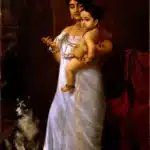Image Courtesy: Google Doodle
Giorgio Vasari (30 July 1511 – 27 June 1574) was an Italian Renaissance painter and architect, who is best known for his work The Lives of the Most Excellent Painters, Sculptors, and Architects, considered the ideological foundation of all art-historical writing.
Early Life And Education
Giorgio Vasari, born on July 30, 1511, in Arezzo, Italy, was a prominent figure of the Italian Renaissance. His family were local tradesmen, and he showed an early inclination towards art. Recognized for his talents, Vasari was recommended by his cousin Luca Signorelli and became a pupil of Guglielmo da Marsiglia, a master of stained glass. At the age of sixteen, he moved to Florence under the patronage of Cardinal Silvio Passerini, joining the circle of Andrea del Sarto and his pupils, Rosso Fiorentino and Jacopo Pontormo. This period was crucial for Vasari as he received a humanist education and was influenced by the works of Michelangelo, who he later befriended. Vasari’s early experiences in Florence, surrounded by the Medici family’s patronage and the city’s vibrant artistic community, shaped his future as a painter, architect, and biographer.
Career And Achievements
Giorgio Vasari most significant contribution to art history is his book “Lives of the Most Excellent Painters, Sculptors, and Architects,” first published in 1550 and then expanded in 1568. This work is considered the foundation of art-historical writing and remains a crucial reference for the study of Renaissance artists. Vasari was not only a chronicler of art but also an accomplished artist and architect himself. He was a proponent of the Mannerist style and received commissions from the Medici family, leading to his work on the Palazzo Vecchio in Florence and the Uffizi Gallery, which began in 1560 and is regarded as a masterpiece of Mannerist architecture. His frescoes adorn many significant buildings, including the Cancelleria in Rome. Vasari’s talents were recognized in his lifetime; he was knighted with the Order of the Golden Spur and held the esteemed position of gonfaloniere in Arezzo. He was also a founding member of the Florentine Accademia e Compagnia delle Arti del Disegno, an institution that still exists today. His legacy is preserved in the Casa Vasari museum in Arezzo and his former residence in Florence.
Notable Events And Milestones
Giorgio Vasari early education under Guglielmo de Marcillat and subsequent training in Florence, where he was under the patronage of the Medici family, significantly shaped his artistic and architectural style. Vasari’s friendships with prominent artists like Andrea del Sarto and his admiration for Michelangelo influenced his work, which is evident in the fresco cycles in the Palazzo Vecchio in Florence and the 100-days fresco in the Cancelleria in Rome.
As an architect, Vasari is celebrated for his designs that reflect the Tuscan Mannerist style, with notable works including the Uffizi in Florence, initiated in 1560 for Cosimo I de’ Medici, and the structures for the Cavalieri di San Stefano in Pisa. However, it is his literary contribution, “Le Vite de’ più eccellenti architetti, pittori, et scultori italiani,” first published in 1550 and then expanded in 1568, that cemented his legacy. This work laid the foundation for art-historical writing, offering a critical history of Western art and presenting a narrative that traced the decline of art after classical antiquity, its resurgence in the 14th century with Cimabue and Giotto, and its culmination in the works of Michelangelo. Vasari’s “Lives of the Most Eminent Painters, Sculptors, and Architects” is considered the ideological foundation of art history, shaping the way we understand and evaluate art and artists. His biographical approach linked the life of an artist to their work, establishing a model that is still used in art historical scholarship today. Vasari’s emphasis on the Renaissance as a rebirth of the arts after the Dark Ages has influenced the cultural narrative of the period, highlighting the importance of individual genius and creativity in the progression of art.
Moreover, Vasari’s own artworks and architectural designs have left a lasting impact on the aesthetic landscape of Italy. His architectural works, such as the Uffizi, not only serve as functional spaces but also as embodiments of Renaissance ideals, harmonizing art and architecture with their surroundings. His frescoes, characterized by their Mannerist style, continue to be admired for their dynamism and complexity, reflecting the intellectual and cultural vibrancy of his time. In addition to his artistic and architectural contributions, Vasari’s role as a historian and biographer has profoundly influenced the way we perceive the Renaissance and its artists. By chronicling the lives and works of his contemporaries and predecessors, Vasari provided a valuable historical record that offers insights into the artistic processes, techniques, and the socio-political context of the Renaissance era. His work has not only preserved the legacy of Renaissance artists but has also provided a framework for the study of art history that extends beyond the Italian Renaissance.
Vasari’s influence extends to the present day, where his principles of art historical writing continue to inform contemporary scholarship. His approach to art history, which emphasizes the importance of context, the artist’s intention, and the technical mastery of the medium, remains a cornerstone of art historical methodology. His narratives have shaped the collective memory of the Renaissance, positioning it as a pivotal moment in the history of Western art. Giorgio Vasari’s life and work represent a confluence of artistic talent, architectural innovation, and scholarly insight. His contributions have left an indelible mark on the history of art, influencing not only the cultural and aesthetic developments of his time but also the way we study and appreciate art across centuries. Giorgio Vasari passed away on June 27, 1574, in Florence, Italy. His impact on art and art history has endured well beyond his lifetime.
Awards And Honors
- Giorgio Vasari was honored by Pope Pius V with the title of Knight of Saint Peter in 1571.
- He was also made Knight of the Golden Spur, a recognition of his contributions to art and architecture.
- Vasari held the prestigious position of the minister of culture to the Medici court in Florence, which was a testament to his influence and status during the Renaissance period.
- He was elected to the municipal council of his native town, Arezzo, and rose to the supreme office of gonfaloniere, reflecting his importance in civic and cultural affairs.
- Vasari’s legacy includes the founding of the Florentine Accademia e Compagnia delle Arti del Disegno in 1563, alongside Grand Duke Cosimo I de’ Medici and Michelangelo.
- His most enduring honor is perhaps his authorship of “The Lives of the Most Excellent Painters, Sculptors, and Architects,” which is considered the ideological foundation of art-historical writing.
- On 30 July 2011, Google celebrated Giorgio Vasari’s 500th Birthday with a doodle.
Additional Resources
Books on Giorgio Vasari:
- “The Lives of the Artists” by Giorgio Vasari, translated by Julia Conway Bondanella and Peter Bondanella, provides a comprehensive look at the lives and works of Renaissance artists, including Vasari himself.
- “Vasari on Technique” offers insight into the methods and materials used by Renaissance artists.
- For a selection of Vasari’s biographies, “The Lives of the Artists” translated by Gaston Du C De Vere is available in a single volume.
Documentaries about Giorgio Vasari:
- “BBC – Travels with Vasari – part one;” is a thorough documentary by Andrew Graham-Dixon exploring Vasari’s life and works.
- “Giorgio Vasari: The Father of Art History” is a short video that provides an overview of Vasari’s contributions to art history.
- For a quick introduction, “Giorgio Vasari – the original Renaissance man” is a brief video highlighting Vasari’s role in art history.
Museums dedicated to Giorgio Vasari:
- The Museo Casa di Giorgio Vasari in Arezzo is the artist’s former home and now a museum showcasing his life and works.
- The Museum of Medieval and Modern Art in Arezzo also houses some of Vasari’s finest works.
- For those interested in seeing Vasari’s influence in architecture, the Logge del Vasari Palace in Arezzo is a notable site.
These resources provide a multifaceted understanding of Giorgio Vasari’s impact on art and art history, offering avenues for both in-depth study and casual exploration.







